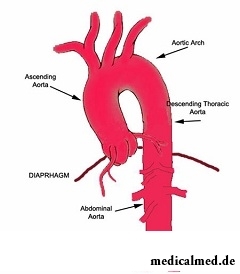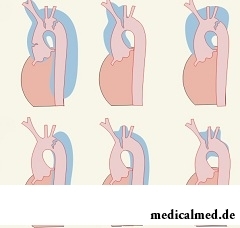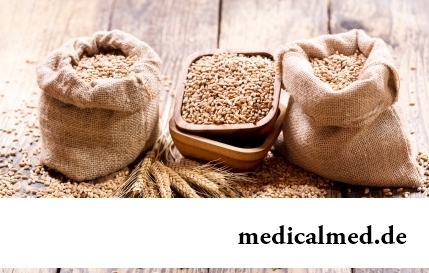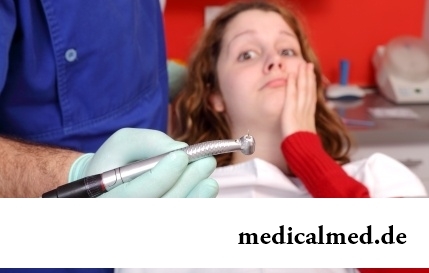





Aortic arch
The aortic arch represents an aorta bend at the level of a breast with transition through the left bronchial tube on the left.
Structure and arrangement of an aortic arch
The aortic arch moves up in the descending aorta with small camber and a bend back. Ahead of an arch there is a small narrowing which is called an aorta isthmus. This isthmus is located between an aortic arch and the descending aorta.
The aortic arch is directed from the second cartilage of an edge to the left 3-4 chest vertebrae. In certain cases branches of an aortic arch reach a brachiocephalic trunk and the right carotid artery, and also there can be development options at which there is a connection of branches of an aortic arch and two brachiocephalic trunks – right and left.
The aortic arch connects to three large vessels - the general carotid artery, a subclavial artery and a brachiocephalic trunk. The largest vessel 4 cm long is the brachiocephalic trunk. It departs from an aortic arch at the level of a sternal and clavicular joint up and is divided into two branches – the right carotid artery and the right subclavial artery. At some features of anatomic development in the person the lowest thyroid artery can depart from a brachiocephalic vessel.
Inborn deformation of an aortic arch
At some cases of abnormal development of an aortic arch there can be its inborn tortuosity which is called deformation. This anomaly of development occurs at 0,4-0,6% of patients with cardiovascular diseases and 3% of patients with aorta coarctation.
Inborn tortuosity of an aortic arch is expressed in its lengthening, an excess and pathological thinning of walls of vessels. In certain cases the aortic arch is condensed and has symptoms of a stenozirovaniye (narrowing).
The reasons of deformation are not established, but medical researches showed that this anomaly begins during pre-natal development under the influence of a number of factors and genetic predisposition.
There are two main types of deformation:
- Inborn deformation with lengthening and bends of an artery;
- Inborn deformation at which the aortic arch is condensed and walls of vessels are narrowed.
Further deformation can develop in several defects:
- Defect with an excess between sleepy and anonymous arteries;
- Defect with an excess of the left sleepy and subclavial arteries;
- Defect with an aorta excess in the place of a branching of a subclavial artery.
In overwhelming number of cases at deformation of an aortic arch of disturbances of blood circulation it is not observed, but load of walls of vessels increases and the aortic aneurysm can be created.
At serious deformation of an aortic arch there can be a squeezing of a gullet, trachea and nervous trunks. For treatment of deformation of an aortic arch the special medicamentous course with the subsequent surgical intervention is appointed.
Aortic arch diseases
Basic diseases of an aortic arch are aneurism and a hypoplasia.
Aneurism of an aortic arch is atherosclerotic or traumatic defeat of vessels. Symptoms of aneurism of an aortic arch are defeats of vessels of heart and a brain, a headache, a pain syndrome in a thorax, an asthma, strong pulsing in a thorax, paresis of a recurrent nerve.
For diagnosis of aneurism the radiographic research and an aortografiya which allows to establish extent of change of a wall of an aorta is conducted. Aneurism of an aortic arch is treated by means of operational prosthetics of an aorta and its branches.
The hypoplasia of an aortic arch represents a hypotrophy of average elements of vessels of an aorta and degenerative changes of a plastic cover which lead to an aorta isthmus break.
Hormonal disturbances, inborn pathologies, genetic predisposition, disturbances of an innervation are origins of a hypoplasia of an aortic arch. The hypoplasia of an aortic arch can affect other arteries, including functioning of a renal artery.
At the serious violations caused by an aorta hypoplasia surgery is performed. After carrying out operation partial correction of heart disease and other cardiovascular diseases is carried out. Then drug treatment by glycosides and diuretics is appointed.
In our intestines are born, millions of bacteria live and die. They can be seen only at strong increase, but if they gathered, then would be located in a usual coffee cup.

Helminthosis is one of the most widespread diseases. Statistically, with any species of helminths it is infected porridges...
Section: Articles about health
Each person supports all life a SARS about 200 times. The peak of incidence falls on cold season, but it is possible to get sick with a temperature and a pharyngalgia, and sometimes and very possibly, even during a heat. The reasons for development of catarrhal diseases exists множество:...
Section: Articles about health
Bulimia and anorexia, are heavy deviations of a feeding behavior, become a cause of death of patients much more often than all other nervous breakdowns combined. In 60% of cases two illnesses accompany each other: patients feel horror before danger of set of excess weight and try to refuse as often as possible food, but periodically suffer from attacks of sudden hunger and an uncontrollable overeating. Each patient with anorexia and bulimia needs the help qualified пс...
Section: Articles about health
The concept "gluten" (differently, a gluten) combines group of the proteins which are a part of rye, barley and wheat. For most of people упот...
Section: Articles about health
Doctors claim that the people not so familiar with a dorsodynia occur among adult Russians very seldom. At the same time the vast majority of the patients who are periodically testing this indisposition do not hurry to ask for medical care at all. With one St...
Section: Articles about health
Practice of use of table salt in the therapeutic purposes contains not one century. Applications which do by means of the fabric impregnated with saline solution are considered especially effective. They have antibacterial and antiinflammatory effect, help to heal wounds, exempt fabrics from excess liquid. Hypertonic salt solution of potassium chloride is applied outwardly at many morbid conditions. Let's tell about the most known of them....
Section: Articles about health
From the failure of work of immune system which is shown in the form of an allergy, statistically, more than 40% of the population of the globe suffer. In большинс...
Section: Articles about health
Antibiotics - - it is possible to call the chemical compounds suppressing growth of bacteria the break in the field of medicine which allowed to save mankind from many diseases incurable earlier: tuberculosis, plague, syphilis and many others. A contribution of drugs to rescue of people from...
Section: Articles about health
The metabolism at each person proceeds in own way. However between the speed of this process and disposal of excess weight after all all have a dependence. Unfortunately, the people inclined to try on itself numerous "miracle" diets, not always consider this circumstance and with the most resolute intentions begin to eat so that artificially slow down the metabolism instead of to accelerate it. Except quite clear disappointment, incorrectly picked up systems...
Section: Articles about health
Dogrose – one of the most widespread adornment and medicinal plants growing practically in all territory ours...
Section: Articles about health
The state of health of the person in many respects depends on chemical composition of biological liquids of an organism. Specialists consider that PH value of these solutions has to be in range of 7,35-7, 45. A deviation in the smaller party (so-called "acidulation") to a chra...
Section: Articles about health
Within several decades of our compatriots convinced that the use of butter nasty affects a condition of coronary vessels. As a result the reputation of a product was impaired thoroughly a little, and many almost ceased to include it in the diet, having given preference "to safer" to vegetable fats. Meanwhile, the last researches showed that harm of butter for health is strongly exaggerated. But the product has a number of unique properties, to...
Section: Articles about health
It is difficult to revaluate importance of kidneys for an organism. These bodies not only perform work on purification of blood of decomposition products and выв...
Section: Articles about health
Tuberculosis – a serious infectious disease which development is caused by mycobacteria (Koch's bacilli). The illness is known from an extreme antiquity. Long time fight against it was considered as ineffective. Quite often the disease affected the whole families, and mortality from it was very much...
Section: Articles about health
Olive oil – the product capable to make a powerful contribution to health of the person if it includes it in the diet. The rich vitamin composition of oil does it by a product number one from many diseases including from deadly. Only two tablespoons of oil from olives in day prevent emergence of diseases of vessels and heart, cancer, problems with digestion, presenilation, a depression and many other illnesses which treatment would demand a lot of time and forces. Let's consider on...
Section: Articles about health
Weakness of an ankle joint – very widespread problem. Its existence is demonstrated by tendency to a podvorachivaniye of legs п...
Section: Articles about health
Quite large number of people adheres to the principles of vegetarian food. But how to be if in a family of vegetarians there are children? Whether it is possible to eat also it the same as to parents, or after all the children's organism is not adapted for the use only раст...
Section: Articles about health
You heard that laughter prolongs life? Researchers did not manage to establish longevity direct link with sincere fun yet, but several facts confirming beneficial influence of risibility on the state of health are clinically proved....
Section: Articles about health
The problem of diagnosis was and remains to one of the most important in medicine. From that, the reason недо will be how precisely defined...
Section: Articles about health
Each person has easy indispositions which he transfers "standing", trying not to ask for medical care. Arguments at the same time are adduced same: "it is a trifle, itself will pass", "I have too many important issues", "there are no wish to spend time on...
Section: Articles about health
Statistically, can only one of ten of our compatriots brag of a decent condition of an oral cavity. Six teeth affected with caries are the share of the average Russian. For comparison, this indicator for Europeans is almost six times less....
Section: Articles about health
Maternal milk is the best food for the newborn. It is the unique natural product containing optimum set...
Section: Articles about health
It would seem, to buy drugs in Moscow does not make a problem – a drugstore, and not one, is available for each resident of the capital within walking distance. And, nevertheless, Internet drugstores become more popular – what it is possible to explain such phenomenon with? Actually m reasons...
Section: Articles about health
More than a half of the married couples which faced prostatitis – leave. The new broadcast "Female View of Prostatitis" will help to learn – whether you have or your relatives problems....
Section: Articles about health
The state of health of the person depends on many factors. One of the most important is the constant but which is not exhausting, motive...
Section: Articles about health
Use of medicinal plants in therapy is urgent today, more than ever. The drugs made of curative herbs cannot replace completely modern synthetic drugs, but their use becomes frequent serious help in simplification a leak...
Section: Articles about health
Striya (extension) are the defects of skin having an appearance of direct or wavy strips from 1 to 10 cm long and 1-5 mm wide. In most cases at women of a striya are located on a stomach, hips, a breast or buttocks. At athletes they can appear on shoulders and the internal surface of forearms. At initial stages of development of an extension have red or lilac color, but over time their coloring turns pale, and strips become whitish, getting a nacreous shade....
Section: Articles about health
